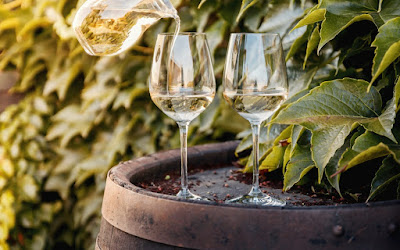Guide to the Wine Flavor Profile
 |
Expecting an array of aromas from wine is not uncommon. First of all, we should understand the difference between primary, secondary, and tertiary aromas. Primary aromas, such as floral scents of rose and red or black fruits, like cherry and blueberry, come from the grapes or grape skin and alcoholic fermentation. As for the secondary aromas, these originate from post-fermentation processes, for instance, lees can provide biscuits, bread, and nutty aromas, and oak can contribute vanilla, toast, and smoke aromas. Lastly, tertiary aromas, developed through maturation and aging, can range from tobacco, leather, petrol, mushroom, dried fruit, and hazelnut to toffee.
Many different aromas can be found in wine, depending on the grape variety, winemaking techniques, and the age of the wine. Some common wine aromas that you should know before you want to buy wine online include:
Red Wine Aromas
The aromas of cherries, strawberries, raspberries, blackberries, and blueberries are common in many red wine bottles. Spice such as black pepper, cloves, cinnamon, or other spices. Some red wines can have aromas of earth, soil, or mushrooms too. Also, some red wine bottles can have delicate floral aromas like violets or herbs like thyme, rosemary, or sage.
Red wines that have been aged in oak barrels can exhibit aromas of vanilla, caramel, or toast. Leather or Tobacco - some aged fruity wines such as Cabernet Sauvignon can have aromas of leather or tobacco as tertiary aromas.
White Wine Aromas
Aromas of citrus range from the bright and zesty aroma of lemon and lime to the sweeter, more floral scent of orange blossom. Aromas of tropical fruit such as peaches, apricots, and nectarines are common in many fruity white wine bottles. Notes of pineapple, mango, and papaya are often found in white wines from warmer regions. White wines such as Chenin Blanc or Pinot Grigio can also have delicate floral aromas like elderflower, jasmine, or honeysuckle. Also, some white wine bottles can have mineral aromas like flint or wet stones and exhibit aromas of herbs like thyme, oregano, or mint.
For secondary aromas, white wines that have undergone malolactic fermentation or have been aged in oak barrels can exhibit the flavour of bread dough, vanilla, or baking spices.
It's important to note that the exact aromas present in wine will depend on many factors, and each wine in the wine store will have its unique profile of aromas and flavors.
How to Taste Wine
The most remarkable aspect of tasting wine is the nose. The human nose's ability to detect and distinguish different odors was not fully understood until recent research. Now we know that the human nose can discriminate at least 1 trillion olfactory odors, signals from receptors traveling to the brain via nerves, and interpreted with known descriptors such as blueberry, cherry, etc. The best way to identify aromas is to fill one-third of the glass to allow for space to swirl—a good swirl will release the aromatic compounds. Instead of taking a deep sniff like smelling a flower, several short but 3-5 times repetitive smells will increase our perception, similar to the way dogs are the best olfactory examiners in the universe. This entire smelling process should take no more than 2 seconds because nose receptors close themselves for about 30-60 seconds as a protection for the body, a process known as olfactory fatigue. The best way to neutralize the nose between smells is to smell the arm or wait for a few minutes. But usually, one smell is not enough to detect all odor compounds. A second smell will be necessary, and even after a minute, the smell may change due to aeration and some masked flavors can become detectable.
Palate tasting is a key part of the process. Professional tasters follow a certain protocol to evaluate the fruit flavor: they take a small sip of wine and roll it around their mouth, allowing it to coat their entire tongue since each part has different receptors. For instance, acidity can be identified by the saliva-inducing effect on the side of the tongue, and bitterness is experienced at the back. Additionally, the weight of the wine, such as acidity is felt on the tongue and tannin levels can be determined by the mouth-drying effect. An often-made mistake is taking a quick sip - since receptors take varying amounts of time to react, the wine should stay on the palate for at least fifteen seconds for a thorough assessment.
Even while sipping wine, the retro-nasal senses are in action to detect more wine flavors. Taking a breath by slightly opening the mouth helps to aerate the wine, promoting the odors and volatilized aroma molecules. This practice will create a gurgling sound that may appear strange in a restaurant setting but is quite common during wine tasting.
Before you buy wine online or visit a wine store, you are now aware of the source of the various aromas in different types of wine. To get the most out of your reading experience, take a look at our blog page for an array of intriguing and informative content.



Comments
Post a Comment